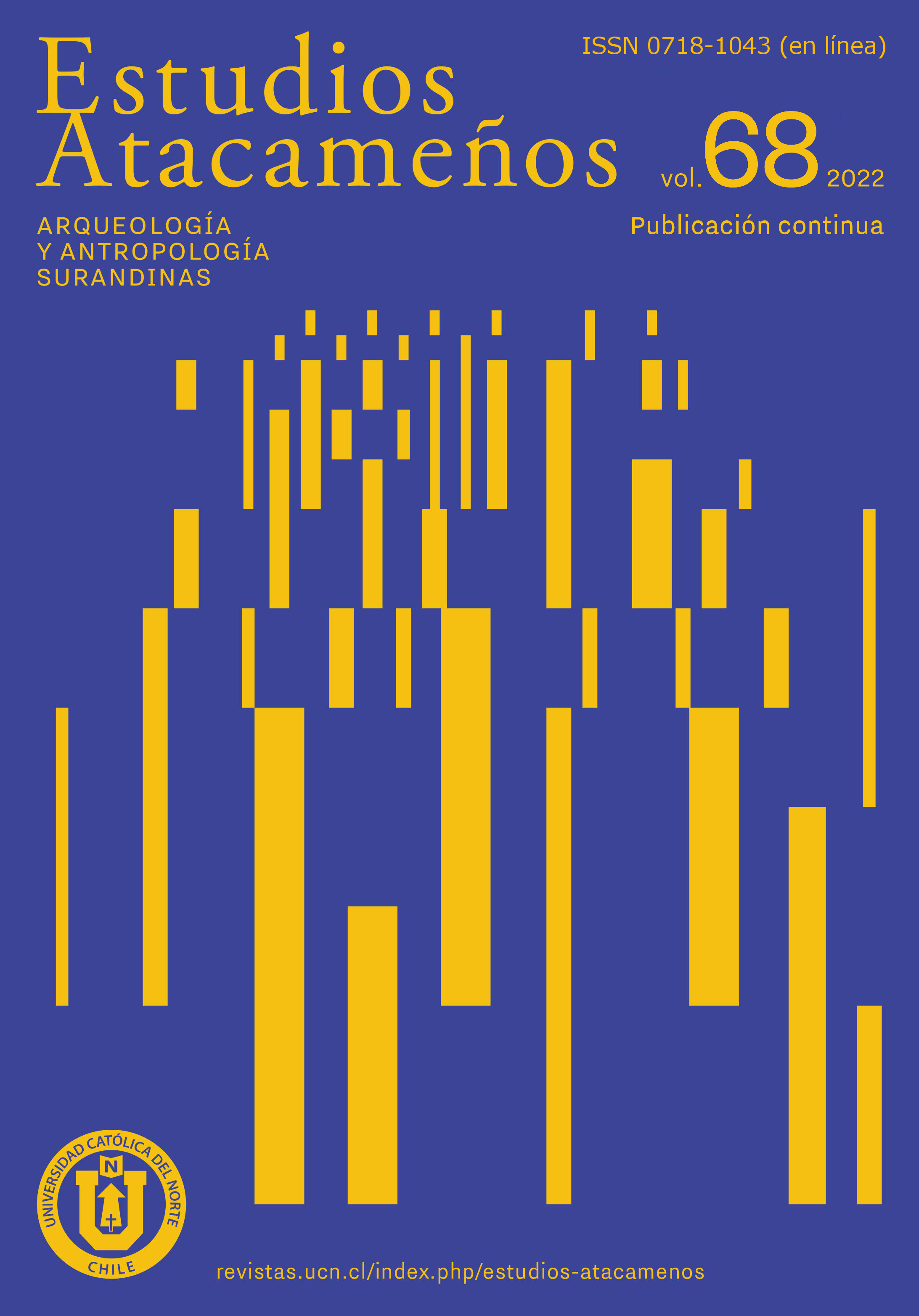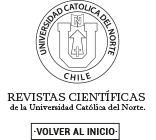Camelids from hunter-gatherer contexts of the Dry Puna in the Atacama Desert (Northern Chile)
Towards understanding human-animal interactions over time
DOI:
https://doi.org/10.22199/issn.0718-1043-2022-0036Keywords:
archaeozoology, stable isotopes, Andean foothills near Arica, mobilityAbstract
The Dry Puna in extreme northern Chile lies between the Andean region’s two main camelid domestication centers, a location that makes it particularly important to the study of human-animal relationships. This article presents a first synthesis of the archeozoological analysis of fourteen hunter-gatherer sites in the Andean foothills near Arica (Chile), the preliminary results of stable isotope analyses from two locations, and 35 associated radiocarbon dates. Researchers contrasted this data with other regional studies of lithic materials and rock art paintings. In synthesis, the article recognizes changes in consumption throughout Archean up to the Formative Period. It identifies the use of animals from the same area or with the same foraging pattern in the Puna and explores a “conservative” mobility pattern within the highlands. Finally, the changes in human-camelid interactions portrayed in rock art complement the vision drawn from bone fragment analysis, reflecting the importance of integrating different material and visual registers into discussions of these issues.
Downloads
References
Alcántara, V., Barba, R., Barral Del Pino, J., Crespo, A., Eiriz, A., Falquina, A. y Pérez Gil, M. (2006). Determinación de procesos de fractura sobre huesos frescos: un sistema de análisis de los ángulos de los planos de fracturación como discriminador de agentes bióticos. Trabajos de Prehistoria, 63(1), 37–45.
Aldenderfer, M. (1998). Asana and the South-Central Andean Archaic. University of Iowa Press.
Aldenderfer, M. (2008). High elevation Foraging societies. En Silverman, H. e Isbell, E. (Eds.) Handbook of South-American Archaeology (pp.131-143). Kluwer Academic/Plenum Publishers.
Baied, C. y Wheeler, J. (1993). Evolution of high Andean Puna ecosystems: Environment, Climate, and Culture Change over the Last 12,000 Years in the Central Andes. Mountain Research and development 13(2):145-156.
Behrensmeyer, A. (1975). The taphonomy and paleoecology of Plio-Pleistocene vertebrate assemblages east of lake Rudolf, Kenya. Bulletin Museum Comparative Zoology 146: 473-578.
Behrensmeyer, A. (1978). Taphonomic and Ecologic Information from Bone Weathering. Paleobiology, 4(2), 150-162.
Benavente, A. (1992). Determinación de especies de camélidos sudamericanos. Un enfoque arqueozoológico. Revista Chilena de Antropología, (11), 41-59.
Berenguer, J. (1996). Identificación de camélidos en el arte rupestre de Taira: ¿Animales silvestres o domésticos? Chungara Revista de Antropología Chilena, 28 (1-2), 85-114.
Betancourt, J., Latorre, C., Rech, J., Quade, J., y Rylander, K. (2000). A 22,000 –Year Record of monsoonal Precipitation from Northern Chile’s Atacama Desert. Science (289), 1542 – 1546.
Blumenschine, R. (1995). Percussion marks, tooth marks, and experimental determinations of the timing of hominid and carnivore access to long bones at FLK Zinjanthropus, Olduvai Gorge, Tanzania. Journal of Human Evolution, (29), 21-51.
Blumenschine, R., Marean, C. y Capaldo, S. (1996). Blind tests of inter-analyst correspondence and accuracy in the identification of cut marks, percussion marks and carnivore tooth marks on bone surfaces. Journal of Archaeological Science, (23), 493–507.
Bonavia, D. (1996). Los Camélidos sudamericanos: una introducción a su estudio. IFEA-UPCH-Conservation International.
Boyd, B. (2017). Archaeology and Human-Animal relations: Thinking Through Anthropocentrism. Annual Review of Anthropology, (46), 299-316.
Brain, C. (1967). Bone weathering and the problem of the pseudo tools. South African Science, 63(3), 97-99.
Brain, C. (1981). The hunters or the hunted?An Introduction to African cave taphonomy. University Press.
Browman, D. (1974). Pastoral nomadism in the Andes. Current Anthropology 15 (2), 188-196.
Buc, N. (2012). Tecnología ósea de cazadores recolectores del humedal del Paraná Inferior (Bajíos ribereños meridionales). Arqueología de la Cuenca de la Plata, Serie monográfica. Instituto nacional de Antropología y pensamiento latinoamericano.
Bugueño, D. 2018. Tecnología lítica y áreas de actividad en el sitio La Puerta durante momentos finales del Arcaico Temprano: Un sitio a cielo abierto en la precordillera del extreme norte de Chile. [Memoria de título de Arqueóloga]. Universidad de Tarapacá.
Capriles, J. M. y Tripcevich, N. (2016). The archaeology of Andean pastoralism. University of New México Press.
Cartajena, I. 1994. Determinación de restos óseos de camélidos en dos yacimientos del Loa Medio (II Región). Estudios Atacameños, (11), 21-49.
Cartajena, I. (2013). Faunal assemblages from the Middle Holocene: Environmental and cultural variability in the western slope of the Puna de Atacama. Quaternary International, (307), 31-37.
Cartajena, I., Benavente, M. A., Núñez, L. y Thomas, C. (2009). La utilización de los camélidos durante el Formativo Temprano: una comparación entre la cuenca del Loa medio y el Salar de Atacama. En López, P., Cartajena, I., García, C. y Mena, F. (Eds.), Zooarqueología y Tafonomía en el Confín del Mundo (pp. 45-58). Universidad Internacional SEK.
Cartajena, I., Nuñez, L. y Grosjean, M. (2007). Camelid domestication on the western slope of the Puna de Atacama, northern Chile. Anthropozoologica, 42 (2), 155-173.
Castillo, C. (2016). Relaciones humano-animal durante el periodo Arcaico (10.500-3.700 A.P.): Aproximación arqueozoológica en la precordillera de Arica, extremo norte de Chile. [ Tesis de Maestría en Antropología]. Universidad de Tarapacá-Universidad Católica del Norte, Arica.
Castillo, C. (2018). La presencia animal en el registro arqueológico de los Andes del extremo norte de Chile. Síntesis, avances y desafíos pendientes. Cuadernos del Instituto Nacional de Antropología y Pensamiento Latinoamericano, 6(2), 1-14.
Castillo, C. (2020). Historias de huesos y animales: Estudios tafonómicos sobre el registro óseo animal en tiempos cazadores recolectores en Mullipungo, cuenca de Tignamar (precordillera del norte de Chile). [Tesis de Doctorado en Antropología]. Universidad de Tarapacá- Universidad Católica del Norte, Arica.
Castillo, C. y Sepúlveda, M. (2017). Objetos “misceláneos” y dinámicas sociales en contextos cazadores recolectores de la precordillera de Arica, extremo norte de Chile. Chungara Revista de Antropología Chilena, 49(2), 159-174.
Chaix, L. y Méniel, P. (2005). Manual de arqueozoología. Barcelona, España: Ariel Prehistoria.
Crabtree, P. J. (1990). Zooarchaeology and complex societies: some uses of faunal analysis for the study of trade, social status, and ethnicity. En Schiffer, M.B. (Ed.) Archaeological Method and Theory 2 (pp. 155-205). University of Arizona Press.
Chester, S. (2008). A wildlife guide to Chile. Princeton University Press.
De Nigris, M. (2005). De fracturas y otros huesos. Consumo de médula en Patagonia Meriodonial. Actas de XIII Congreso Nacional de Arqueología Argentina (pp. 109-116), Córdoba, Argentina.
De Nigris, M. y Mengoni Goñalons, G. (2005). The guanaco as a source of meat and fat in the Southern Andes. En Mulville, J. y Outram, A. (Eds.), The zooarchaeology of fats, oils and dairying (pp. 160-166). Oxbow Books.
Diaz-Maroto, P., Rey-Iglesia, A., Cartajena, I., Núñez, L., Westbury, M.V., Varas, V., Moraga, M., Campos, P. F., Orozco-terWengel, P., Marin, J. C. y Hansen, A. J. (2021). Ancient DNA reveals the lost domestication history of South American camelids in Northern Chile and across the Andes. ElifeMar 16;10:e63390. doi: 10.7554/eLife.63390.
Dransart, P. (1999). La domesticación de los camélidos en los Andes Centro-Sur. Una reconsideración. Relaciones de la Sociedad Argentina de Antropología, XXIV, 125-138.
Dransart, P. (2001). Llamas, herders and the exploitation of raw materials in the Atacama Desert. World Archaeology, 22(3), 304-319.
Dudognon, C. (2016). Entre chasse et pastoralisme, l'art rupestre de la région d'Arica-Parinacota (Chili). [These de Doctorat en Préhistoire]. Université de Toulouse.
Dudognon, C. y Sepúlveda, M. (2015). Scenes, camelids and anthropomorphics style variations in the north Chile’s rock art during Archaic and Formative transition. En Collado, H. y García, J.J. Proceedings of XIX Internacional Rock Art Conference IFRAO 2015 (pp. 217-230). Arkeos.
Dudognon, C. y Sepúlveda, M. (2018). Rock art of the upper Lluta valley, northernmost of Chile (South Central Andes): A visual approach to socio-economic changes between Archaic and Formative periods (6,000–1,500 years BP). Quaternary International, (491), 136-145.
Dufour, E., Goepfert, N., Gutiérrez, B., Chauchat, C., Franco, R. y Vásquez, S. (2014). Pastoralism in Northern Peru during Pre-Hispanic Times: Insights from the Mochica Period (100–800 AD) Based on Stable Isotopic Analysis of Domestic Camelids. PLoS ONE 9(1):e87559. doi : 10.1371/journal.pone.0087559.
Dufour, E., Goepfert, N., Le Neün, M., Prieto, G. y Verano, J. (2020). Life History and Origin of the Camelids Provisioning a Mass Killing Sacrifice During the Chimú Period: Insight from Stable Isotopes. Environmental Archaeology, (25), 310-324. https://doi.org/10.1080/14614103.2018.1498165
Fernández Jalvo, Y. y Cáceres, I. (2010). Tafonomía e industria lítica: marcas de corte y materias primas. En Mata Almonte, E. (Ed.), Cuaternario y Arqueología: Homenaje a Francisco Giles Pacheco (pp. 277–290). Servicio de publicaciones, Asociación profesional del patrimonio Histórico-Arqueológico de Cádiz.
Fernández López, S. (1995). Tafonomía y fosilización. En B.Mélendez (Ed.), Tratado de paleontología (pp 51-107). Consejo Superior de Investigaciones científicas.
France, D. (2009). Human and nonhuman bone identification. A color atlas. CRC Press.
García, M. y Sepúlveda, M. (2011). Contextos vegetales asociados a aleros pintados de la precordillera de Arica (extremo norte de Chile). Estudios Atacameños, (41), 97-118.
Gallardo, F. y Yacobaccio, H. (2007). ¿Silvestres o domesticados? camélidos en el arte rupestre del Formativo Temprano en el desierto de Atacama (norte de Chile). Boletín del Museo Chileno de Arte Precolombino, 12(2), 9-31.
Garreaud, R. (2009). The Andes climate and weather. Advances in Geosciences, (7), 1–9.
Gayo, E.M., Martens, T., Stuart-Williams, H., Fenner, J., Santoro, C.M., Carter, C. y Cameron, J., (2020). Procurement of camelid fiber in the hyperarid Atacama Desert coast: Insights from stable isotopes. Quaternary International, (548), 71-83.
Grant, J. (2017). Of Hunting and Herding: Isotopic evidence in wild and domesticated camelids from the Southern Argentine Puna (2120–420 years BP). Journal of Archaeological Science: Reports, (11), 29-37.
Goepfert, N. y Alva, W. (2018) ¿Festejando con los señores mochicas? Hacia una revaluación de los festines y comidas rituales prehispánicos en Los Andes Centrales. Latin American Antiquity, 29(2), 331-349.
Grayson, D. (1984). Quantitative Zooarchaeology. Academic Press.
Grebe, M. (1984). Etnozoología andina: concepciones e interacciones del hombre andino con la fauna altiplánica. Estudios Atacameños, (7), 335- 347.
Guerrero-Bueno, Z. y Sepúlveda, M. (2018). Arte rupestre pintado en el alero Pampa El Muerto 11 de la precordillera de Arica: propuesta estilística y secuencia cronológica. Boletín del Museo Chileno de Arte Precolombino, 23(2), 79-97.
Guerrero-Bueno, Z. y Sepúlveda, M. (2020). Paisajes pintados a través del tiempo en las tierras altas andinas: el arte rupestre de Pampa Oxaya, precordillera de Arica (Chile). Cuadernos de Arte Prehistórico, (1), 144-188.
Guiry, E.J., Szpak, P. 2020. Quality control for modern bone collagen stable carbon and nitrogen isotope measurements. Methods in Ecology and Evolution, (11), 1049-1060.
Herrera, K., Ugalde, P., Osorio, D., Capriles, J., Hocsman, S. y Santoro, C. (2015). Análisis tecno-tipológico de instrumentos líticos del sitio arcaico temprano Ipilla-2 en los Andes de Arica, Chile. Chungara 41(1):41-52.
Hill, E. (2013). Archaeology and animal persons. Toward a Prehistory of Human-Animal Relations. Environment and Society: Advances in Research, (4), 117–136.
Hocsman, S. y Aschero, C. (2015). Caracterización de los grupos tipológicos de las gubias, los escoplos y los cinceles. Comechingonia 19 (2), 281-296.
Jackson, A.L., Inger, R., Parnell, A.C., Bearhop, S. (2011). Comparing isotopic niche widths among and within communities: SIBER – Stable Isotope Bayesian Ellipses. R. Journal of Animal Ecology, (80), 595-602.
Ingold, T. (2000). The Perception of the Environment. Essays on Livelihood, Dwelling and Skill. Routledge.
Isaac, G. (1967). Toward the interpretation of occupational debris: some experiments and observations. Kroeber Anthropological Society Papers, (37), 31-57.
Izeta, A. (2008). Late Holocene camelid use tendencies in two different ecological zones of Northwestern Argentina. Quaternary International, (180), 135-144.
Izeta, A., Srur, M. y Labarca, R. (2012). Guía osteométrica de camélidos sudamericanos. Universidad Nacional de Córdoba.
Johnson, E. (1985). Current Developments in Bone Technology. En Schiffer, M. (Ed.) Advances in Archaeological Method and Theory (pp. 157-235). Academic Press.
Karr, L. (2015). Human use and reuse of megafaunal bones in North America: Bone fracture, taphonomy, and archaeological interpretation. Quaternary International, (361), 332-341.
Karr, L. y Outram, A. (2012). Tracking changes in bone fracture morphology over time: environment, taphonomy, and the archaeological record. Journal of Archaeological Science,(30), 555-559.
Kauffmann, C. (2009). Determinación de edad y sexo en guanaco. Estudios actualísticos y arqueológicos en Pampa y Patagonia. Sociedad Argentina de Antropología.
Kent, J. (1982). The domestication and exploitation of the South American camelids [Tesis de Doctorado en Arqueología ]. Washington University.
Lavallée, D. (2006). Secuencias y consecuencias de algunos procesos de neolitización en los Andes Centrales. Estudios Atacameños, (32), 35-42.
Lefebvre, R. (2004). Hakenasa: the archaeology of a rock shelter in the Altiplano of northern Chile. [Tesis Doctoral en Antropología]. University of New Brunswick.
López, P., Cartajena, I., Loyola, R., Núñez, L. y Carrasco, C. (2017). The use of hunting and herding spaces: stable isotope analysis of Late Archaic and Early Formative camelids in the Tulan Transect (Puna de Atacama, Chile). International Journal of Osteoarcheology, 27(6), doi: 10.1002/oa.2631.
Lumbreras, L. G. (2006). Un Formativo sin cerámica y cerámica preformativa. Estudios Atacameños, (32), 11-34.
Lyman, R. (1994) Vertebrate Taphonomy. Cambridge Manuals in Archaeology. University Press.
Lynch, T. F. (1971) Preceramic Transhumance in the Callejón de Huaylas, Perú. American Antiquity, (36), 139–148.
Mallye, J.-B., Costamagno, S., Laroulandie, V. y Beauval, C. (2009). Impacts des processus périglaciaires sur la préservation des ossements. Les nouvelles de l’archéologie, 26–31.
Mengoni Goñalons, G. (1988). El estudio de huellas en arqueofaunas: una vía para reconstruir situaciones interactivas en contextos arqueológicos: aspectos teórico-metodológicos y técnicas de análisis. En Ratto, N. y Haber, A. F. (Eds.), De procesos, Contextos y otros Huesos (pp. 17-28). Instituto de Ciencias Antropológicas.
Mengoni Goñalons, G. (1999). Cazadores de guanacos de la estepa patagónica. Colección Tesis Doctorales. Sociedad Argentina de Antropología.
Mengoni Goñalons, G. (2008). Camelids in ancient Andean societies: a review of the archaeological evidence. Quaternary International,(185),59-68.
Mengoni Goñalons, L., Arroyo-Cabrales, J., Polaco, O. y Aguilar, F. (2010). Estado actual de la arqueozoología latinoamericana. Instituto Nacional de Antropología e Historia, Consejo Nacional de Ciencia y Tecnología, International Council for Archaeozoology, Universidad de Buenos Aires.
Moore, K. (1989). Hunting and the Origins of Herding in Peru [Tesis de Doctorado en Arqueología ]. University of Michigan
Moreno, A., Santoro, C. y Latorre, C. (2009). Climate change and human occupation in the northernmost Chilean Altiplano over the last ca. 11 500 cal. a BP. Journal of Quaternary Science, 24 (4), 373-382.
Niemeyer, H. (1972). Las pinturas rupestres de la sierra de Arica. Santiago: Editorial Jerónimo de Vivar.
Niemeyer, H. y V. Schiappacasse (1963). Investigaciones Arqueológicas en las Terrazas de Conanoxa, Valle de Camarones (Provincia de Tarapacá). Revista Universitaria, (26), 101–153.
Núñez, L. (2006). Patrones, cronología y distribución del arte rupestre arcaico Tardío y formativo temprano en la cuenca de Atacama. En Podestá, M. y Fiore, D. (Eds.), Tramas en la piedra. Producción y usos del arte rupestre (pp. 191-204). World Archaeological / Congreso-AINA-SAA.
Núñez, L. y C. Santoro. (1988). Cazadores de la puna seca y salada del área Centro sur andina (norte de Chile). Estudios Atacameños, (9), 13-65.
Núñez, L. y Santoro, C. (2011). El tránsito arcaico-formativo en la circumpuna y valles occidentales del centro sur andino: hacia los cambios “neolíticos”. Chungara Revista de Antropología Chilena , (43), 487-530.
Osorio, D., Capriles, J., Ugalde, J. P., Herrera, K., Sepúlveda, M., Gayo, E., Latorre, C., Jackson, D. y Santoro, C. (2017a). Hunter-Gatherer Mobility Strategies in the High Andes during the Late Pleistocene Holocene transition (ca.11.500-9.500 cal yr BP)”. Journal of Field Archaeology, 42 (3), 228-240.
Osorio, D., Jackson, D., Ugalde, J. P., Latorre, C., De Pol-Holz, R. y Santoro, C. (2011). Hakenasa Cave and its relevance for the peopling of the southern Andean Altiplano. Antiquity, 85, 1-15.
Osorio, D., Sepúlveda, M., Castillo, C. y Corvalán, M. (2016). Análisis lítico y funcionalidad de sitios de los aleros de la precordillera de Arica (Centro-Sur andino) durante el período Arcaico (ca. 10.000-3.700 años A.P.). Intersecciones en Antropología, (17), 77-90.
Osorio, D., Steele, J., Sepúlveda, M., Gayó, E., Capriles, J., Herrera, K., Ugalde, J. P., de Pol- Holz, R., Latorre, C. y Santoro, C. (2017b). The Dry Puna as an ecological megapatch and the peopling of South America: Technology, mobility, and the development of a late Pleistocene/early Holocene Andean hunter-gatherer tradition in northern Chile. Quaternary International, http://dx.doi. org/10.1016/j.quaint.2017.07.010
Olivera, D. y Grant, J. (2008). Economía y ambiente durante el Holoceno Tardío (ca. 4500-400) de Antofagasta de la Sierra (Puna Meridional Argentina). En Acosta, A., Loponte, D. y Mucciolo, L. (Eds.), Temas de Arqueología. Estudios tafonómicos y zooarqueológicos, I (pp. 99-131). Instituto Nacional de Antropología y Pensamiento Latinoamericano.
Pacheco,V., Altamirano, A. y Guerra, E. (1979). Guía Osteológica de Camélidos Sudamericanos. Universidad Nacional Mayor de San Marcos.
Parnell, A.C., Inger, R., Bearhop, S. y Jackson, A.L. (2010). Source Partitioning Using Stable Isotopes: Coping with Too Much Variation. PLOS ONE, 5, e9672.
Peres, T. (2010). Methodological issues in Zooarchaeology. En Van Derwarker, A. y Peres (Eds.), Integrating Zooarchaeology and Paleoethnobotany: A consideration of issues, methods and cases (pp. 15-36). Springer.
Potter, S. (2005). The physics of cutmarks. Journal of Taphonomy, 3(2), 91–106.
Reitz, E. y Wing, E. (2008). Zooarchaeology. Cambridge University Press.
Renard-Casevitz, F. (1979). Su-açu. Essai sur les cervidés de l’Amazonie et sur leur signification dans les cultures indiennes actuelles. Travaux de l’Institut Français d’Études Andines.
Rojas, E. (2016). El recurso vegetal durante el Arcaico Temprano (10.000 a 8.000 años a.p.): el caso del sitio Alero El Bajo, sector de Mullipungo, precordillera de la región de Arica y Parinacota- Chile. [Memoria de título de Arqueólogo]. Universidad de Tarapacá.
Samec, C., Morales, M. y Yacobaccio, H. (2014). Exploring Human Subsistence Strategies and Environmental Change through Stable Isotopes in the Dry Puna of Argentina. International Journal of Osteoarchaeology, 24(2), 134-148.
Samec, C., Pirola, M., Yacobaccio, H. y Panarello, H. (2020). Assessing Prehispanic Herding Strategies through stable Isotope Analysis: A Case Study from the Dry Puna of Argentina. Environmental Archaeology, 25(3), 353-364.
Santoro, C. (1987). Settlement patterns of Holocene hunting and gathering societies in the south-central Andes. [Tesis para optar al grado de Master of Arts]. Cornell University.
Santoro, C. (1989). Antiguos cazadores de la puna (9000 a 6000 a.C.). En Hidalgo, J., Schiappacasse, V., Niemeyer, H., Aldunate,C. y. Solimano, I. (Eds.), Prehistoria. Desde sus orígenes hasta los albores de la conquista (pp. 81-105). Editorial Andrés Bello.
Santoro, C. y Chacama, J. (1982). Secuencia cultural de las tierras altas del área centro-sur andina. Chungara Revista de Antropología Chilena , (8), 33-62.
Santoro, C. y Chacama, J. (1984). Secuencia de asentamientos precerámicos del extremo norte de Chile. Estudios Atacameños, (7), 71-84.
Santoro, C. y Núñez, L. (1987). Hunters of the Dry Puna and the Salt Puna in Northern Chile. Andean Past, (1), 57-109.
Santoro, C., Osorio, D., Ugalde, J. P., Sepúlveda, M., Cartajena, I., Standen, V., Gayo, E., Maldonado, A., Rivadeneira, M., Latorre, C., Arriaza, B., Rothhammer, F., De Souza, P., Carrasco, C. y Núñez, L. (2016). Cazadores recolectores y pescadores arcaicos del desierto de Atacama. Entre el Pacífico y los Andes. Norte de Chile (ca. 10.000-3.700 A.P.). En Aldunate, C., Falabella, F., Sanhueza, L. y Uribe, M. (Eds.), Prehistoria: Culturas de Chile (pp. 117-180). Editorial Universitaria.
Schiappacasse, V. y Niemeyer, H. (1996). Las pictografías de los aleros de Itiza y de Mullipungo de la Sierra de Arica. Chungara, 28 (1-2): 253-276.
Sepúlveda, M., Cornejo, L., Osorio, D., Uribe, M., Llanos, C. y Castillo, C. (2018). Cazadores- recolectores en tiempos formativos. Trayectoria histórica local en la Precordillera del extremo norte de Chile. Chungara Revista de Antropología Chilena, 50(1), 29-50.
Sepúlveda, M, García, M., Calás, E., Carrasco, C. y Santoro, C. (2013). Pinturas rupestres y contextos arqueológicos de la precordillera de Arica (extremo norte de Chile). Estudios Atacameños, (46), 27-46.
Sepúlveda, M., Saintenoy, T., Cornejo, L., Dudognon, C., Espinoza, F., Guerrero, Z. y Cerrillo, E. (2019). Rock Art Painting and Territoriality in the precordillera of northernmost Chile (South Central Andes). Archaeological and Spatial Approaches to the Naturalistic Tradition. Quaternary International, 43 , 254-263.
Sepúlveda, M., Saintenoy, T, Faúndes, W. (2010) Rock paintings of the precordillera region of northern Chile. Rock Art Research, 27(2), 161-175.
Sierpe, V. (2015). Atlas osteológico del guanaco (Lama guanicoe). Ediciones Universidad de Magallanes.
Szpak, P., Chicoine, D., Millaire, J.-F., White, C.D., Parry R. y Longstaffe, F.J. (2016). Early Horizon camelid management practices in the Nepeña Valley, north-central coast of Peru. Environmental Archaeology, (21), 230-245.
Szpak, P., Millaire, J.-F., White, C.D., Lau, G.F., Surette, F. y Longstaffe, F.J. (2015). Origins of Prehispanic Camelid Wool Textiles from the North and Central Coasts of Peru Traced by Carbon and Nitrogen Isotopic Analyses. Current Anthropology, (56), 449-459.
Szpak, P., Millaire, J.-F., White, C.D. y Longstaffe, F.J. (2014). Small scale camelid husbandry on the north coast of Peru (Virú Valley): Insight from stable isotope analysis. Journal of Anthropological Archaeology, (36), 110-129.
Szpak, P. y Valenzuela, D., (2020). Camelid husbandry in the Atacama Desert? A stable isotope study of camelid bone collagen and textiles from the Lluta and Camarones Valleys, northern Chile. PLOS ONE, 15 (3), e0228332.
Szpak, P., White, C.D., Longstaffe, F.J., Millaire, J.-F., Vásquez Sánchez, V.F., 2013. Carbon and Nitrogen Isotopic Survey of Northern Peruvian Plants: Baselines for Paleodietary and Paleoecological Studies. PLOS ONE, (8), e53763.
Tieszen, L.L. y Chapman, M. (1992). Carbon and nitrogen isotopic status of the major marine and terrestrial resources in the Atacama Desert of northern Chile. First World Congress on Mummy Studies (pp. 409–425). Museo Arqueológico y Etnográfico de Tenerife.
Thomas, K. (1996). Zooarchaeology: Past, present and future. World Archaeology, 28 (1), 1-4.
Valenzuela, D., C. Santoro, J. Capriles, M. Quinteros, R. Paredo, E. Gayo, I. Montt y M. Sepúlveda. (2015). Consumption of animals beyond diet in the Atacama Desert, northern Chile (13.000-410 BP): Comparing rock art motifs and archaeofaunal records. Journal of Antrhopological Archaeology, (40), 250-265.
Villa, P. y Mahieu, E. (1991). Breakage patterns of human long bones, Journal of Human Evolution, 21 (1), 27-48.
Wheeler, J. (1985). De la chasse à l'élevage. En Lavallée, D., Julien, M., Wheeler, J. y Karlin, C. (Eds.), Telarmachay Chasseurs et Pasteurs Préhistoriques des Andes (pp. 61-79). Editions Recherche sur les Civilisations Synthese 20.
Wheeler, J. (1991). Origen, evolución y estatus actual. En Fernández Baca, S. (Eds.), Avances y perspectivas del conocimiento de los camélidos sudamericanos (pp. 11-48). Oficina regional de la FAO para América Latina y el Caribe.
Wheeler, J. (2012). South American camelids, past, present and future. Journal of Camelid Science, (5), 1-24.
Wheeler, J., Pires Ferreira, E. y Kaulicke, P. (1977). Domesticación de los camélidos en los Andes Centrales durante el período precerámico: un modelo. Journal de la Société des Américanistes, (64), 155-165.
Wheeler, J., Russel, A. y Rydden, H. (1995). Llamas and alpacas: pre-conquest breeds and post-conquest hybrids. Journal of Archaeological Science, (22), 833-840.
Yacobaccio, H. (2003). Procesos de intensificación y de domesticación de camélidos en los Andes Centro-Sur. Memorias del Tercer Congreso Mundial sobre Camélidos. Tomo I: 211-216. Potosí, Bolivia.
Yacobaccio, H. (2004). Social dimensions of camelid domestication in the southern Andes. Anthropozoologica, (39), 237–247.
Yacobaccio, H. (2007). Andean camelid herding in the South Andes: ethnoarchaeological models for archaeological research. Anthropozoologica, 42(2),143-154.
Yacobaccio, H. (2009). The historical relationship between people and the vicuña. En Gordon, I. (Ed.), The Vicuña. The theory and practice of community-based wildlife management (pp. 7-20). Sustainable ecosystems townsville.
Yacobaccio, H. (2012). Towards a human ecology for the middle Holocene in the Southern Puna. Quaternary International, (307), 24-30.
Yacobacco, H. (2021). The domestication of South American camelids: a review. Animal Frontiers, 11(3), 43-51.
Yacobaccio, H., Gallardo, F. y Sepúlveda, M. (2022). Interacción humano- camélido en la Puna de Atacama (área surandina): caza y demografía humana desde el arte rupestre. Latin American Antiquity. doi:10.1017/laq.2022.2.
Yacobaccio, H., Madero, C., Malmierca, M. y Reigadas, M. (1997-1998). Caza, domesticación y pastoreo de camélidos en la Puna Argentina. Relaciones de la Sociedad Argentina de Antropología, 22(3), 389-429.
Yacobaccio, H. y Vilá, B. (2012). La domesticación de los camélidos andinos como proceso de interacción humana y animal. Intersecciones en Antropología, (14), 227-238.
Yacobaccio, H. y Vilá, B. (2016). A model for llama (Lama glama Linnaeus, 1758) domestication in the southern Andes. Anthropozoologica, 51(1), 5-13.
Downloads
Published
Issue
Section
License
Copyright (c) 2022 Camila Castillo, Marcela Sepúlveda, Eugenia Gayo, Elise Dufour, Nicolas Goepfert, Daniela Osorio

This work is licensed under a Creative Commons Attribution 4.0 International License.

All works published in Revista Estudios Atacameños (ISSN on line:0718-1043) Revista Estudios Atacameños Creative Commons International 4.0 attribution (CC BY 4.0) licence.
Authors remain the owners of their work and may republish their articles elsewhere without having to request permission, as long as they indicate that the work was originally published in Revista Estudios Atacameños (ISSN on liine:0718-1043).












